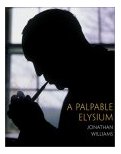|
Contents » Cover |
||
|
Reviews
Jonathan Williams: lover of fine things. If you've ever tried to truly be in love with anything—art, music, people—you know that love and admiration are much more difficult than we imagine simply because it's hard to find anything worth our time and attention. Jonathan Williams has spent his life seeking out art, music, and people on which we can spend our sacred time and attention. A Palpable Elysium is his photographic guide. In 1982 in his introduction to Williams's selected poems Get Hot or Get Out, Robert Peters elucidates Williams's poetic originality, an originality that emerges in the images of his new book A Palpable Elysium. Peters writes: "Williams is antiquarian, and, at the same time, very modern ('postquarian')." Further, Peters explains that Williams is a "sleuth," sniffing out genius in both high and low culture. It is this—Williams's taste for the genius of both elite and folk culture—that jumps out at me when I view the photographs in A Palpable Elysium. Williams's photograph of Jack Spicer, for instance, demonstrates this merging of the folk and elite. We see Spicer dressed in common clothes standing atop downed redwoods in northern California. Williams's letter to Jack on the opposing page tells us that Spicer had spent the night before drinking at a bar with the common folk. It also includes this quote from Spicer, "Poetry is for poets." You can't get any more elite than that. And it's true in Spicer's case. Unfortunately, poets, not basketball players, read Spicer. Spicer himself in this image is a mere whisp of a man compared to the mammoth logs in this folksy image. Perhaps suggesting the mammoth task of the artist— Also in this fine line up of touchable, heavenly greats are familiar literary names like William Carlos Williams and Ezra Pound. These two are arranged in the book side-by-side: folk and elite, juxtaposed. There are a number of images of grave sites—poets or artists dead before Williams could meet them: Walt Whitman, Edward Estlin Cummings, Wallace Stevens, and Jelly Roll Morton. Perhaps the most curious and intriguing photographs are of the visionary folk artists Williams has so long supported and promoted. If you've never met St. Eom (Eddie Owens Martin) and encountered his visionary planet, you've not yet experienced true American verve. And what about my neighbor who recently passed on to the Elysium Fields—the "indomitable Georgia Blizzard," an unparalleled potter? A Palapable Elysium hosts other brave minds rendered in Williams's photographs: Henry Miller (looking so California), Charles Olson (looking like a Mafia man), Guy Davenport (who writes the introduction to this book), Robert Duncan (small mouth, large mind), Lorine Niedecker (don't know her? Get a copy of her poems NOW), Basil Bunting (under a Yew tree in Briggsflat), Paul Strand (yes, the photographer), Kenneth Rexroth (the one and only), Simon Cutts (minimalist poet extraordinaire), Elijah Pierce (religious folk artist and life-long barber), the one and only Buckminster Fuller (yep, geodesic dome designer), Howard Finster (southern visionary), a young Thomas Meyer (poet, translator, star gazer), Vollis Simpson (giant whirligig maker), and Wendell Berry (writer and farmer . . . Williams says these two occupations mixed together tend to piss people off). If you've never come across some of these names, then you must grab a copy of A Palpable Elysium. Williams has assembled a cast of artists that ol' Houghton Mifflin won't show you. And all the better, these folks are authentic, not mass produced. So be it: A Palpable Elysium.
|
|||||
